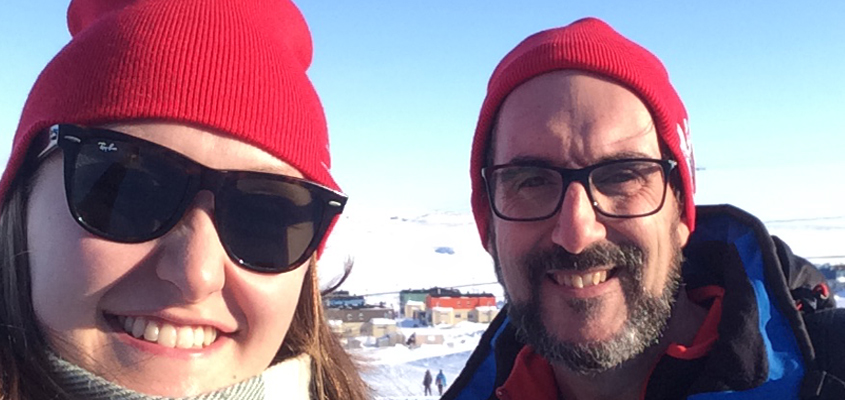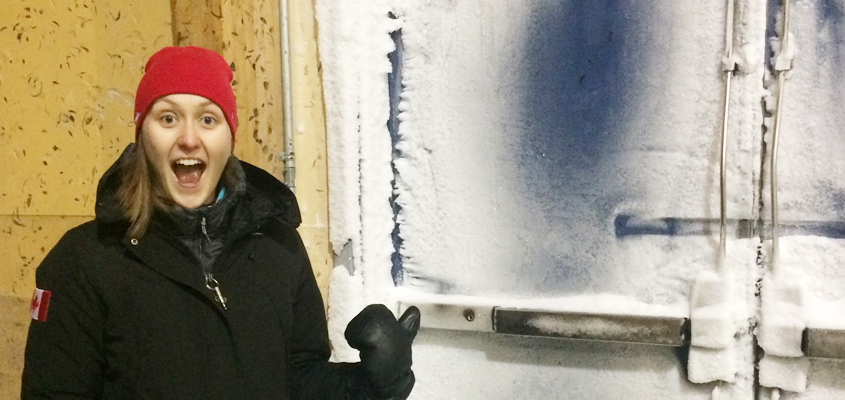It all started with a tweet to Sportsnet 590 The Fan, and three weeks later Professor John Cairney and graduate student Zoe Poucher found themselves in Inukjuak, an Arctic village located on Hudson Bay in northern Quebec. They were there to witness the final select camp for the Nunavik Youth Hockey Development Program.
Run by Joé Juneau, a former NHL player who started the program in 2006, the camp welcomed Inuit youth from 14 villages across Nunavik to train and compete against teams in Quebec and Ontario.
When Cairney, from U of T’s Faculty of Kinesiology and Physical Education, heard that the program was going to be cut, he contacted 590 The Fan and offered his help. Juneau accepted and from March 10 to 20, Cairney and Poucher visited the camp for girls aged 13 to 17, and spent every day in the arena observing three-hour practices and classroom lessons on coping, confidence, and team building. They interviewed parents, former players, coaches, community members and the mayor, and spent time observing and interacting with the coaches and the players.
They explain why they went and what their experience was like.
How did you end up in Nunavik to witness the final girls select hockey camp?
JC: When I heard Joé being interviewed on the radio, he said that the program was being cut due to a consultant’s report. He raised some points about the methodology and it sounded like he had a legitimate concern. I tweeted the show’s host and to my surprise he announced on air that “Dr. John Cairney from U of T is reaching out.” From there I was connected to the producer of the show and to Joé. It was amazing to see how fast this all unfolded through social media.
I volunteered to review the report as an independent scientist and then Joé invited me to visit the final camp. Intrigued at the prospect, I then reached out to Professor Katherine Tamminen for a possible collaboration because of her expertise in qualitative methodology and sport psychology, and she recommended her graduate student Zoe. The intent wasn’t to refute the report but it became an opportunity to witness something really special.
 Zoe Poucher and Professor John Cairney enjoy one of the few sunny days of their trip
Zoe Poucher and Professor John Cairney enjoy one of the few sunny days of their trip
Why was funding for the program cut?
JC: The program was funded under a crime-prevention program run by Makivik Corporation. A report conducted by a consulting firm found that there was no causal link between the select program and crime prevention. We saw it in a different light – the program was what we call in the sport developmental literature a sport-plus program – it used hockey as an opportunity to build resilience, promote positive life skills and support positive development. We also witnessed something else – it offered respite from the challenges these girls face – hockey, even though it may be only for a brief time, was a diversion. There wasn’t a day that there wasn’t a significant event. While we were there a young person committed suicide.
Were you especially surprised by anything?
ZP: When you see practices with 13 year olds in Ontario, their attention is usually scattered and they’re chatting. But these girls were extremely focused. There was no talking between drills and on water breaks they’d all go get water, have a sip and then take a knee and listen. That level of focus clearly translated into results since the team from this camp recently won a tournament in Ottawa. It’s amazing because they have a lot fewer resources and have barely trained together.
JC: We had heard before about some of the social challenges of the North – poverty, overcrowding, substance abuse and violence. But to witness this first hand was difficult. At the same we also saw evidence of resilience and children and families living their lives to the best of their abilities, as we all do.
On the hockey side, the arena looked like any small town arena you might see in Ontario, and it had typical championship banners. But along the far side, there were 10 to 13 banners that were dedicated to individuals who had died, and those people were mostly in their early 20s. The main causes of death in that region are suicide or accidents. In our more local arenas, you might see one or two banners honouring a player, coach or community leader who passed away. This was different, and given the context, very poignant.
What was it like to conduct research in the Arctic?
ZP: It was -10 C in the arena, so we wore a lot of layers. There was a Tim Horton’s there, so I drank a lot of hot chocolate and then we’d go to the lobby area to get warm.
JC: I had visions of us sitting with our laptops in the arena, but it was so cold we had to make our observations using a tape recorder. To keep warm, we walked around and stomped our feet. I have a photo of Zoe standing beside the back doors of the arena, which are frozen shut.
 Poucher shows just how cold it is in the Arctic
Poucher shows just how cold it is in the Arctic
Outside of research, what was your experience like?
JC: We ate freeze dried food and some local delicacies, and we were treated really well by our hosts. The area is so expansive – you look out and it’s just ice and snow and it goes forever. It feels like you’re the only person in the world. You close your eyes and listen to nothing.
ZP: It’s very isolated. The only way to get there is by plane or boat and there are no roads. It was neat to see the Northern lights – a couple of locals said that if you whistle, they’ll come lower to you – we were out one night and we could hear someone whistling. It was also really windy! We visited an inuksuk and we could barely stand upright when we were at that higher elevation.
What are your plans for the future?
JC: It’s an experience that will stay with us for the rest of our lives. We’re writing a short report of our observations and data of what we think are two main critiques of the original report. We’re aiming to finish this in a few months. There may be something bigger too – perhaps a monograph of the program and our experiences. We need to see about that. Overall, we’re hoping to do justice to the last select camp and to provide an honest account of a special program.
